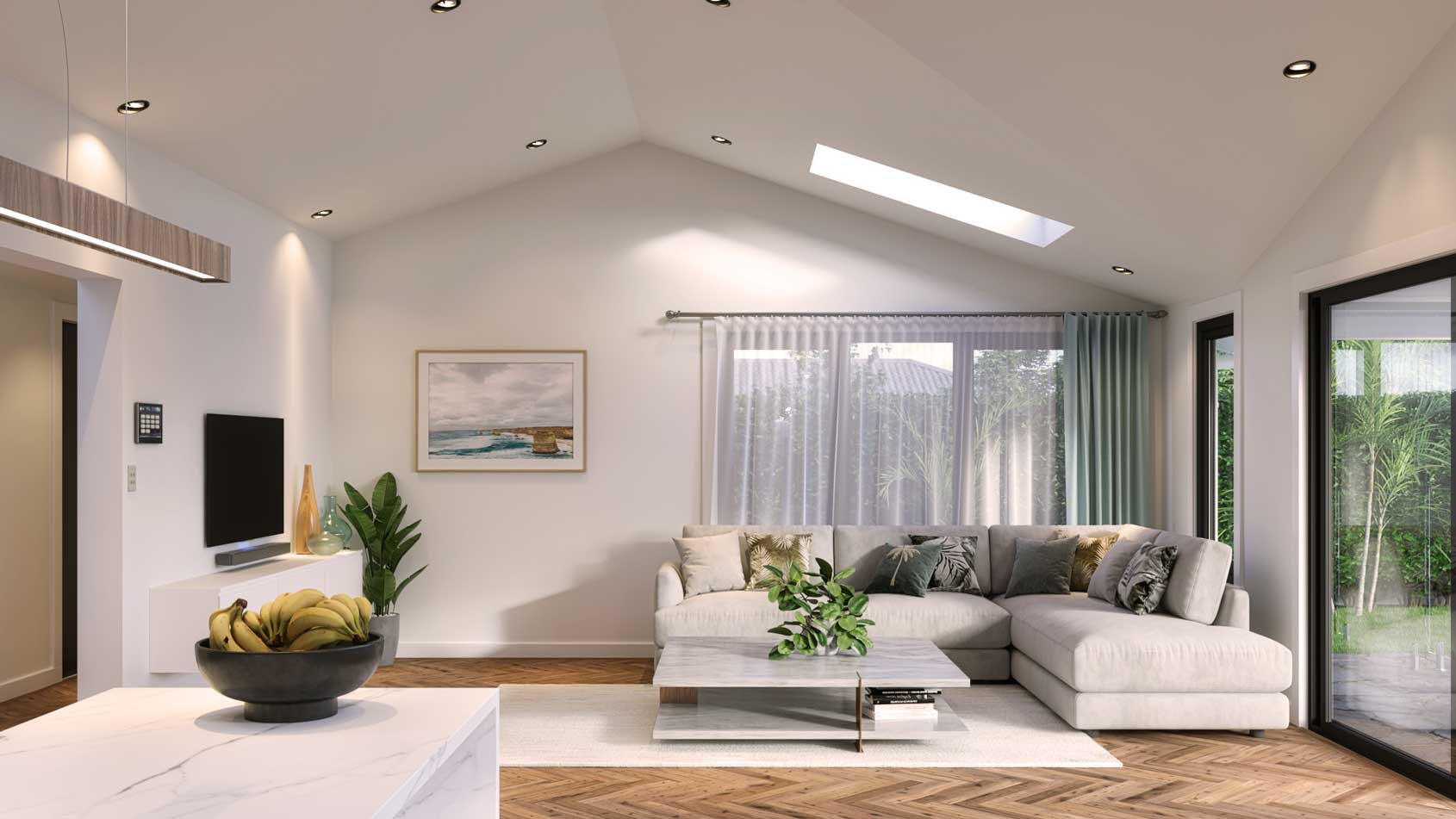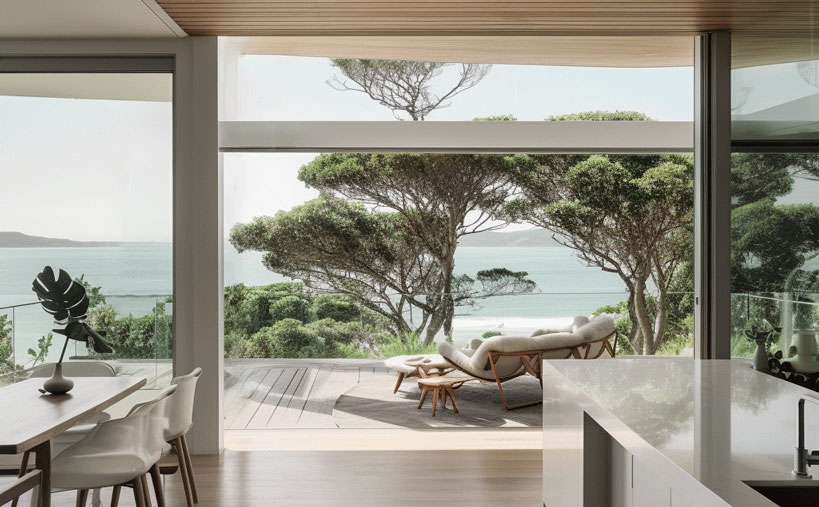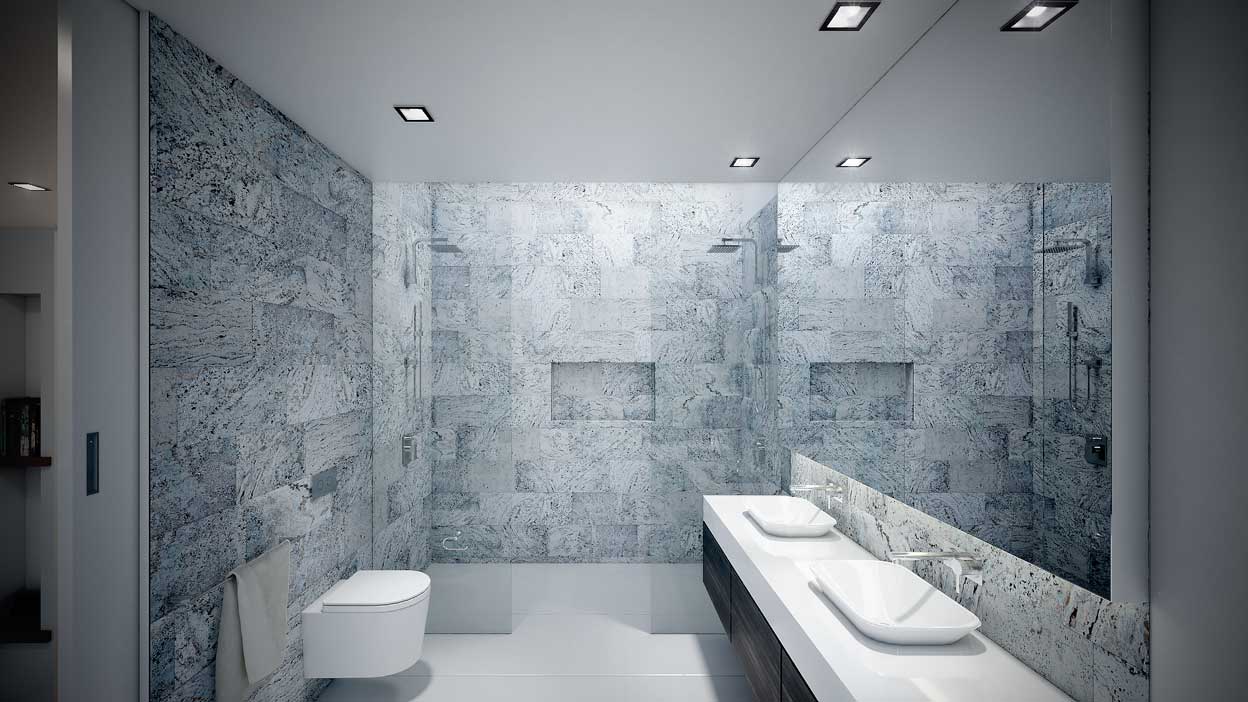Picture yourself in a beautifully designed coastal home, basking in the warm glow of sunlight streaming through the windows as you enjoy your morning coffee.
Natural light plays a crucial role in contemporary coastal design, not only in terms of aesthetics but also in enhancing the functionality of spaces and promoting energy efficiency.
In this post, we’ll explore the various ways in which architects use natural light to create stunning, sustainable, and comfortable coastal environments.
Enhancing Coastal Design with Aesthetic Benefits of Natural Light
Natural light plays a pivotal role in coastal design aesthetics, contributing to the creation of inviting, open spaces.
The following section explores how architects utilise natural light to enhance a sense of space, showcase stunning views, and highlight architectural features and materials in contemporary coastal designs.
1.Creating a Sense of Space and Volume
The use of natural light in contemporary coastal design is a powerful tool in creating a sense of spaciousness and volume. By strategically incorporating elements such as large windows, skylights, and creating open floor plans, architects can enhance the perception of space, making interiors feel larger, more open, and inviting.
Here’s how these elements contribute to this effect:
-
Large windows: Large windows not only allow for an abundance of natural light to enter the space but also create a visual connection with the outdoors. This connection extends the perceived boundaries of the interior, making it feel more expansive. Additionally, windows placed on opposite sides of a room can create a cross-illumination effect, further enhancing the sense of space.
-
Skylights: Skylights introduce light from above, filling the room with a soft, diffused glow. This overhead lighting creates an even illumination throughout the space, eliminating dark corners and giving the room a more spacious and airy feel. Skylights can also add a sense of height to a space, as the eye is naturally drawn upwards towards the source of light.
-
Open floor plans: Open floor plans, common in coastal architecture, remove barriers between rooms and allow light to flow freely throughout the space. By eliminating walls and partitions, spaces feel larger and more interconnected, creating an overall sense of openness and volume. This open layout also allows for flexibility in the arrangement of furniture and other elements, which can contribute to the perception of spaciousness.
-
Reflective surfaces: Incorporating reflective surfaces, such as mirrors, glass, or polished metal, can enhance the presence of natural light in a space. These surfaces bounce light around the room, effectively multiplying the amount of light and giving the illusion of a larger, brighter space.
-
Light color palette: A light color palette, often associated with coastal design, can further amplify the sense of spaciousness in a room. Light colors reflect more natural light, making the room appear brighter and more open. This effect is particularly pronounced when combined with large windows or skylights, as the incoming light interacts with the light-colored surfaces to create an even greater sense of volume.

2. Enhancing Views and Connection to the Outdoors
Coastal homes are often blessed with stunning ocean, beach, or native bushland views. To capitalise on these views, architects use natural light through the strategic placement of windows or glass doors to enhance views and create a strong connection between indoor and outdoor spaces.
This design approach not only elevates the aesthetic appeal of a space but also contributes to the occupants’ overall well-being and comfort. Here are some ways in which architects achieve this:
-
Maximizing natural light: By incorporating large windows or sliding glass doors, architects can introduce natural light into interior spaces. This creates an inviting and warm atmosphere, while also reducing the need for artificial lighting which contributes to energy efficiency.
-
Framing views: Strategically placed windows and glass doors can frame captivating views of the surrounding landscape, functioning as ever-changing pieces of art. This design approach draws the eye outward and creates a visual extension of the indoor space, making it feel larger and more open.
-
By enhancing the sense of space with natural light, it also reduces the need for artificial light sources and thus improves energy efficiency.
-
Creating seamless transitions: Using sliding glass doors or large, retractable window panels can create a seamless transition between indoor and outdoor spaces. When opened, these elements effectively eliminate the barrier between the interior and exterior, allowing for easy movement and integration of the two areas.
-
More importantly, these design choices allow for greater penetration of natural light into the home, reducing dependence on artificial lighting and increasing energy efficiency.
-
Incorporating outdoor elements: Architects often use natural materials, such as stone or wood, to establish a visual connection between the interior and exterior of a building. By using these materials both inside and outside a building, a sense of continuity and harmony is created, further blurring the line between indoors and outdoors.
-
Additionally, lighter-toned natural materials can effectively reflect sunlight into deeper parts of the home, helping to distribute natural light more evenly and reducing the need for energy-consuming artificial lights.
-
Integrating indoor and outdoor living: To promote a strong connection between indoor and outdoor spaces, architects might design outdoor living areas that mirror the interior layout. This could include outdoor kitchens, dining areas, or lounge spaces that are easily accessible from the main living areas of the home.
-
These spaces, when designed with ample overhangs or pergolas, can also mitigate excess sunlight during peak hours, contributing to a naturally cooler interior and reducing the need for air conditioning. This ultimately enhances energy efficiency.

3. Highlighting Architectural Features and Materials
Natural light can be a powerful tool in accentuating architectural features and materials within a space. By carefully considering the placement of windows, skylights, and other openings, architects can create dynamic lighting effects that enhance the visual interest and beauty of the built environment.
Here are some ways in which natural light can be used to highlight architectural features:
-
Clerestory windows: Clerestory windows placed high on a wall can introduce sunlight from above, casting dramatic shadows on textured feature walls or other architectural elements. This effect adds depth and visual interest to the space, drawing attention to the unique features of the design.
-
Light wells: Light wells are vertical openings within a building that allow natural light to penetrate deep into the interior. These openings can be used to create striking light effects on surrounding surfaces, such as walls, floors, or staircases, emphasizing the architectural form and materials.
-
Window placement: The strategic placement of windows can direct natural light onto specific architectural elements, like columns, beams, or sculptural details. By illuminating these features, the interplay of light and shadow accentuates their form and adds an additional layer of visual interest to the space.
-
Translucent materials: The use of translucent materials, such as frosted glass or light-diffusing panels, can create a soft, even illumination that highlights the texture and detail of surfaces like wood, stone, or concrete. Use of this gentle type of light enhances the natural beauty of these materials and adds a sense of depth to the space.
-
Sun-shading devices: Architectural elements like louvers, brise-soleil, or pergolas can be used to manipulate the entry of natural light, creating intricate patterns of light and shadow on a building’s surfaces. These sun-shading devices not only add a dynamic visual element to the design but also serve a functional purpose by controlling heat gain and glare.
-
Solar orientation: By carefully considering the solar orientation of a building, architects can design spaces that receive optimal natural light during specific times of the day. For instance, east-facing windows can capture the warm, golden light of the morning sun, while west-facing windows can create dramatic, long shadows in the late afternoon.

Harnessing Natural Light for Functionality and Energy Efficiency in Coastal Design
Natural light is integral to coastal design, enhancing both visual appeal and energy efficiency. In this section, we explore the various benefits of incorporating natural light in coastal architecture, such as reducing artificial lighting needs and improving indoor air quality.
1. Reducing the Need for Artificial Lighting
By maximizing the use of natural light in coastal homes, architects can significantly reduce the need for artificial lighting during daytime hours. This not only contributes to energy savings but also reduces the overall carbon footprint of the building.
To further enhance energy efficiency, architects might incorporate daylight-responsive lighting systems that automatically adjust the intensity of artificial lights based on the amount of natural light available.
2. Improving Indoor Air Quality and Ventilation
Natural light can also contribute to a healthier indoor environment. Sunlight has been shown to reduce the growth of mould and mildew, which can cause respiratory issues and other health problems.
Moreover, the use of operable windows and skylights can improve ventilation, allowing fresh air to circulate throughout the space and reducing the reliance on energy-intensive air conditioning systems.
3. Solar Shading and Passive Solar Design
While maximizing natural light is a key goal in coastal design, it’s also essential to prevent excessive solar heat gain, which can lead to uncomfortable indoor temperatures and increased cooling costs.
Architects often employ solar shading strategies, such as overhangs, pergolas, and louvers, to control the amount of sunlight entering a space while still allowing for ample daylight.
Passive solar design is another important consideration in coastal architecture. This approach involves strategically designing and orienting a building to take advantage of the sun’s energy for heating and cooling purposes.
For example, architects might incorporate thermal mass materials, such as concrete or stone, that can absorb heat during the day and release it at night, helping to maintain comfortable indoor temperatures.
Promoting Health and Well-being Through Natural Light in Coastal Design
Natural light plays a crucial role in the health and well-being of occupants in coastal homes and commercial spaces. As such, it also forms a key component of biophilic design. By thoughtfully incorporating natural light into the design, architects can create environments that are not only visually stunning but also promote a healthy lifestyle.
In this section, we’ll discuss the various health benefits of natural light, including improved mood, support for healthy circadian rhythms, and enhanced cognitive function.

1. Improved Mood
One of the most significant benefits of natural light in design is its ability to improve mood.
Sunlight is known to stimulate the production of serotonin, a neurotransmitter responsible for maintaining a balanced mood and promoting feelings of happiness and well-being.
By designing spaces with ample access to natural light, architects can create environments that help reduce stress and anxiety, contributing to a happier and more relaxed atmosphere for occupants.
2. Support for Healthy Circadian Rhythms
Exposure to natural light is crucial for maintaining healthy circadian rhythms, which regulate our sleep-wake cycles and impact our overall health and well-being.
Our bodies use sunlight as a cue to regulate the production of melatonin, a hormone that controls our sleep patterns.
By ensuring that living and working spaces receive an adequate amount of natural light during the day, architects can support occupants’ circadian rhythms, leading to better sleep quality, increased energy levels, and improved overall health.
3. Improved Cognitive Function
Research has shown that exposure to natural light can have a positive impact on cognitive function, including memory, attention, and problem-solving abilities.
Access to natural light in working or learning environments has been linked to increased productivity, improved focus, and reduced mental fatigue.
By designing spaces with an emphasis on natural light, architects can create environments that foster creativity, innovation, and cognitive well-being for occupants.
Illuminating Coastal Spaces: The Impact of Natural Light in Various Areas
In this section, we examine how the thoughtful use of natural light can transform different coastal spaces, from living rooms and kitchens to bedrooms and outdoor living areas.
By exploring various design strategies and their effects, we will highlight the importance of harnessing natural light to create inviting, functional, and aesthetically pleasing environments in coastal homes and buildings.
1. Living Rooms and Common Areas
In coastal living rooms and common areas, natural light serves as a key design element that can set the tone for the entire space.
By incorporating large windows, sliding glass doors, and strategically placed skylights, architects can create bright, welcoming environments that are perfect for relaxation and socialization.
In addition to letting in sunlight, these design features can also enhance the connection to the outdoors, providing stunning views and easy access to outdoor living spaces like decks and patios.
To further optimize the use of natural light in living rooms, architects might choose furniture and accessories with reflective surfaces or light-coloured fabrics. They may also consider the placement of mirrors or artwork to help bounce light around the room, creating a bright, airy atmosphere.
2. Kitchens and Dining Areas
In coastal kitchens and dining areas, natural light is essential not only for creating a pleasant atmosphere but also for improving functionality. Ample sunlight can make food preparation tasks easier and more enjoyable, as well as provide an inviting setting for family meals and entertaining guests.
Large windows, skylights, and sliding glass doors can be used to flood these spaces with natural light, while also offering views of the surrounding landscape.
Additionally, the incorporation of pendant lights or chandeliers with dimmable features can provide supplemental artificial lighting that can be adjusted based on the time of day and specific needs.
3. Bedrooms and Bathrooms
In coastal bedrooms and bathrooms, natural light plays a crucial role in promoting relaxation and well-being.
By designing spaces with large windows or even floor-to-ceiling glass walls, architects can create a strong connection to the outdoors, allowing occupants to wake up to the sight of the ocean or enjoy a soothing bath while taking in the sunset.
When it comes to bedrooms, it’s important to balance the desire for natural light with the need for privacy and light control. Architects may opt for window treatments like blinds, curtains, or shades that can be easily adjusted to let in light during the day while providing privacy and darkness at night.
In bathrooms, the use of frosted or textured glass can allow for ample natural light while maintaining privacy.
Skylights are another popular option for bringing sunlight into bathrooms, as they provide light without compromising wall space for mirrors, storage, and other essential fixtures.
4. Home Offices and Workspaces
With more people working from home than ever before, the importance of well-designed home offices and workspaces has never been more apparent.
Natural light can have a significant impact on productivity and well-being in these spaces, as it has been shown to improve focus, reduce eye strain, and boost overall mood.
To optimize natural light in home offices, architects might consider the placement and size of windows, as well as the use of reflective surfaces and light-coloured paint.
Additionally, incorporating flexible window treatments can allow occupants to control the amount of light entering the space, reducing glare on computer screens and preventing overheating.
5. Outdoor Living Spaces
Coastal architecture often places a strong emphasis on outdoor living, with spaces like decks, patios, and balconies playing a central role in the overall design.
While natural light is abundant in these areas, architects must also consider how sunlight interacts with the various elements of the space throughout the day and across different seasons.
Strategies like adjustable shading devices, such as retractable awnings or pergolas with movable slats, can provide the necessary control over sunlight, ensuring a comfortable environment for outdoor relaxation and entertaining.
Additionally, the use of light-coloured paving materials and outdoor furniture can help create a bright, inviting atmosphere, even on overcast days.
The Final Word…
The role of natural light in contemporary coastal design is multifaceted, contributing to the aesthetic appeal, functionality, and energy efficiency of spaces.
By skilfully harnessing sunlight, architects can create coastal homes and commercial buildings that are not only visually stunning but also comfortable, sustainable, and connected to their natural surroundings.
As coastal architects, we embrace the power of natural light to create spaces that inspire, uplift, and enhance the well-being of those who inhabit them.
So, whether you’re admiring a beautifully lit coastal living room or marvelling at the interplay of light and shadow in a beachfront hotel, take a moment to appreciate the transformative power of natural light in contemporary coastal design.
If you’re interested in learning more about how natural light can transform your property, or if you’re considering a new construction or renovation project, don’t hesitate to get in touch with us.
Take the first step towards a brighter, more sustainable home or commercial space by contacting us today. Together, we can explore the exciting possibilities that natural light and thoughtful design can bring to your property.

